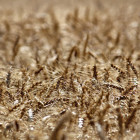K-State Plant Disease Diagnostic Clinic
One of the best preventative measures for wheat streak is the control of volunteer wheat early and often after harvest. If volunteer wheat is allowed to stand, it creates a “green bridge”, allowing wheat streak mosaic and wheat curl mites to survive locally. Volunteer wheat should be terminated at least two weeks prior to planting to allow sufficient time for mites to die off.
Wheat streak mosaic is one of the most economically devastating wheat diseases in Kansas and the Great Plains. Control of volunteer wheat is the best way to prevent wheat streak mosaic virus losses in the wheat crop.
In 2017, WSMV caused a conservative $76.8 million in direct losses to farmers. [Read more]
Stop the Streak
There are basically only three ways to control the spread of wheat streak mosaic:
- Timely removal of volunteer wheat and other grassy weeds. The best way to prevent the spread of the wheat streak mosaic virus is to remove volunteer wheat and other grassy weeds. Volunteer wheat must be completely dead and dry for two weeks before planting a new wheat crop. Volunteer wheat and other grassy weeds can be removed with herbicides or tillage, but it’s absolutely essential to allow time for herbicides to work.
- Avoid early planting; plant after the hessian fly-free date. By avoiding early planting, Kansas wheat farmers are able to avoid times when wheat mite populations are the highest in late summer and to decrease the interval between planting and fall freeze events. "When we say avoid early planting, we’re not talking about planting outside of the window for success of your wheat crop,” said KSU Plant Pathologist Erick De Wolf. “We’re encouraging you to plant on the later side of the recommended planting dates."
- Plant varieties with moderate or high levels of resistance to WSMV.
- At this point in time, there are no chemical options such as insecticides or pesticides that are effective at controlling the wheat curl mite.
Genetic Resistance
Research is headed down the path of genetic resistance, and Kansas wheat farmers should know that help is on the way. However, there are only a few varieties with moderate resistance at the current time.
The WSM3 gene, which was discovered by Bernd Friebe at the Wheat Genetics Resource Center (WGRC) at Kansas State University, comes from wild relatives of wheat and is resistant to not only Wheat Streak Mosaic Virus, but it also provides protection from Triticum Mosaic Virus and High Plains Mosaic Virus as well. Another benefit of WSM3 is that it is not temperature sensitive, which has been a weakness in the current sources of resistance. This research is being partially funded by Kansas wheat farmers through the Kansas Wheat Commission’s two-penny wheat assessment. The WGRC is housed at the Kansas Wheat Innovation Center in Manhattan.
Recent news
-

The long and short of wheat breeding in Hays
May 19, 2015
The next great wheat variety started out as a single cross between two parents. But before that variety is planted in a farmer’s field, it will have been selected and tested over ten to 12 years.
-

Shutting It Down
November 25, 2014
Kansas Researchers Protect Wheat by Preventing Virus Replication Viruses result in yield loss. For example, yield loss due to wheat streak mosaic virus equaled more than 4.25 million bushels in…
-

Plant Prep: Take control of next year's wheat crop
August 27, 2014
While 2014’s wheat harvest has been left in the dust, producers are starting to make decisions that can affect next year’s crop, for both themselves and their neighbors. Being a good neighbor is a…

Planting conditions for 2014 Kansas wheat crop
September 25, 2013
MANHATTAN, Kan-Wheat planting conditions across Kansas tell an unusual story as Western Kansas farmers are excited about moisture and many Central Kansas farmers sit on the sideline praying for rain…
Pagination
- Previous page
- Page 3
